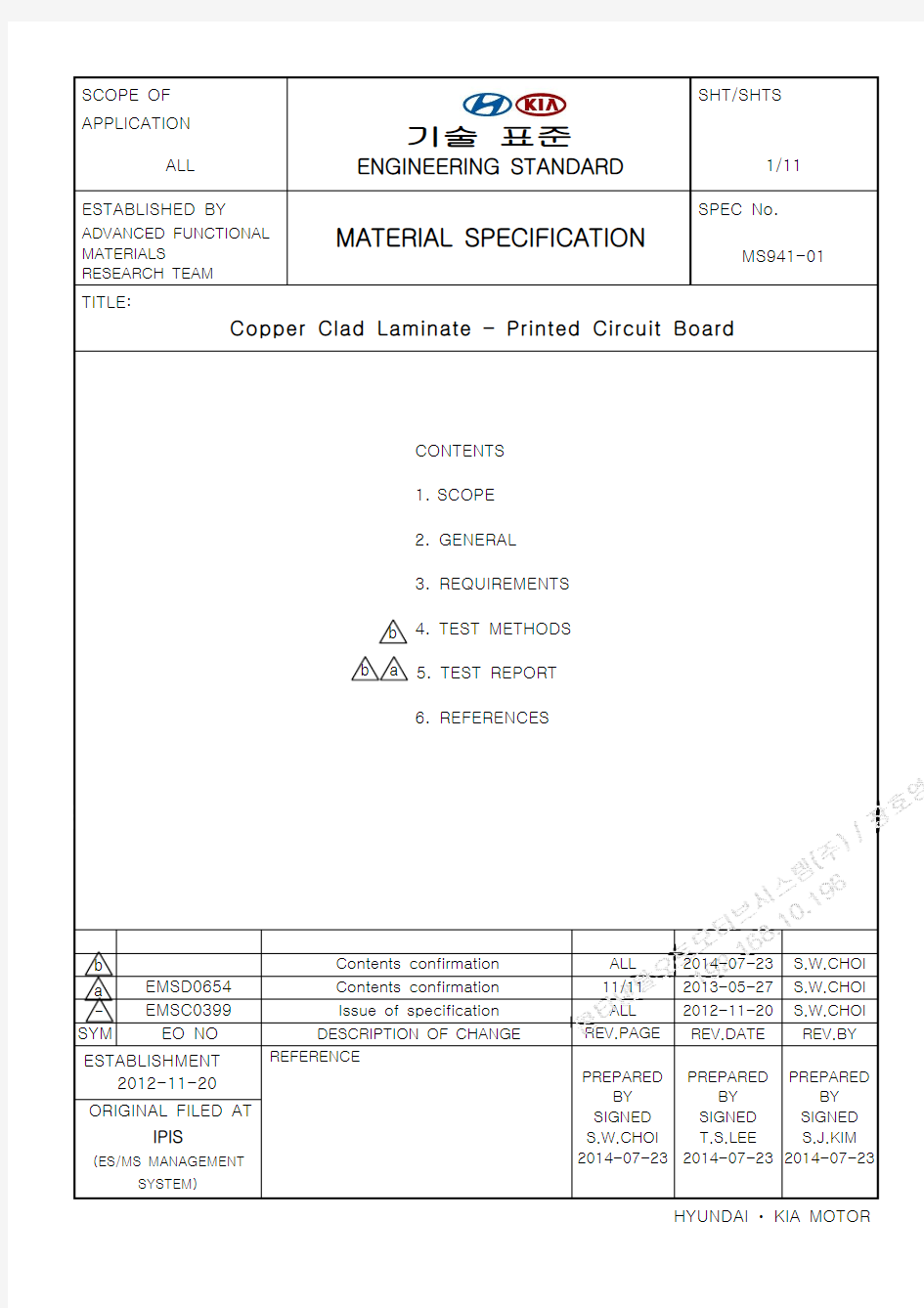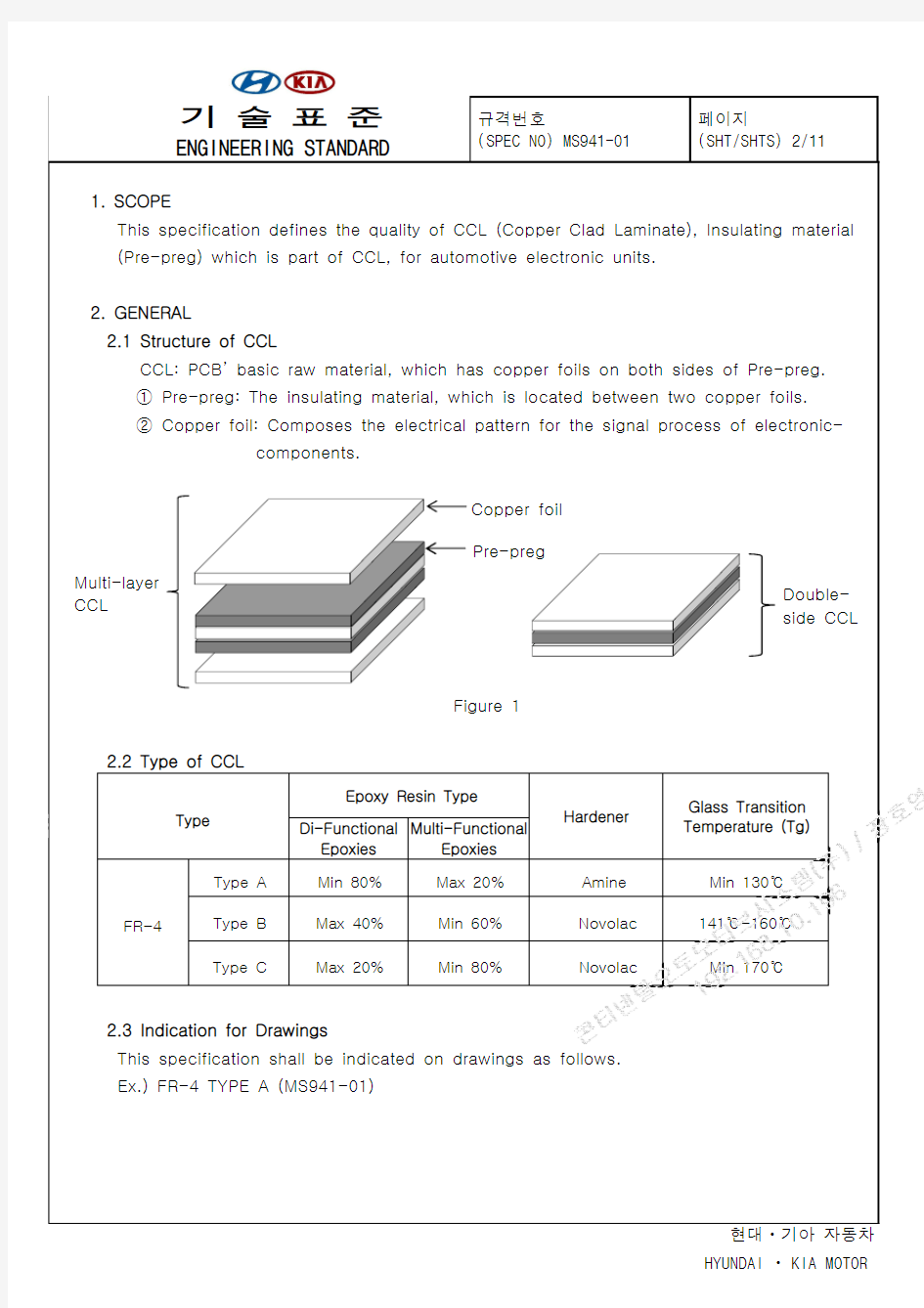

SCOPE OF APPLICATION ALL ESTABLISHED BY
ADVANCED FUNCTIONAL MATERIALS RESEARCH TEAM
SHT/SHTS
?? ??
ENGINEERING STANDARD
1/11 SPEC No.
MATERIAL SPECIFICATION
MS941-01
TITLE:
Copper Clad Laminate – Printed Circuit Board
CONTENTS 1. SCOPE 2. GENERAL 3. REQUIREMENTS b b a 4. TEST METHODS 5. TEST REPORT 6. REFERENCES
b a SYM
Contents confirmation
ALL 11/11 ALL REV.PAGE
2014-07-23 2013-05-27 2012-11-20 REV.DATE
S.W.CHOI S.W.CHOI S.W.CHOI REV.BY
EMSD0654 EMSC0399 EO NO
Contents confirmation Issue of specification DESCRIPTION OF CHANGE REFERENCE
ESTABLISHMENT 2012-11-20 ORIGINAL FILED AT IPIS
(ES/MS MANAGEMENT SYSTEM)
PREPARED PREPARED PREPARED BY BY BY SIGNED SIGNED SIGNED S.W.CHOI T.S.LEE S.J.KIM 2014-07-23 2014-07-23 2014-07-23
HYUNDAI ? KIA MOTOR
????????????(?) / ??? / 2014-08-12 11:38/ ? ??? ???????? ??????? ???? ?? ? ??? ? ???, ?? ??? ??? ?? ?? ? ?? ??? ?? ??? ?? ? ????.
? ? ? ?
ENGINEERING STANDARD
1. SCOPE
???? (SPEC NO) MS941-01
??? (SHT/SHTS) 2/11
This specification defines the quality of CCL (Copper Clad Laminate), Insulating material (Pre-preg) which is part of CCL, for automotive electronic units. 2. GENERAL 2.1 Structure of CCL CCL: PCB’ basic raw material, which has copper foils on both sides of Pre-preg. ① Pre-preg: The insulating material, which is located between two copper foils. ② Copper foil: Composes the electrical pattern for the signal process of electroniccomponents. Copper foil Pre-preg Multi-layer CCL Doubleside CCL
Figure 1 2.2 Type of CCL
Epoxy Resin Type Type Di-Functional Multi-Functional Epoxies Epoxies Type A FR-4 Type B Type C Min 80% Max 40% Max 20% Max 20% Min 60% Min 80% Hardener Glass Transition Temperature (Tg)
Amine Novolac Novolac
Min 130℃ 141℃-160℃ Min 170℃
2.3 Indication for Drawings This specification shall be indicated on drawings as follows. Ex.) FR-4 TYPE A (MS941-01)
????? ??? HYUNDAI ? KIA MOTOR
????????????(?) / ??? / 2014-08-12 11:38/ ? ??? ???????? ??????? ???? ?? ? ??? ? ???, ?? ??? ??? ?? ?? ? ?? ??? ?? ??? ?? ? ????.
? ? ? ?
ENGINEERING STANDARD
3. REQUIREMENTS 3.1 General Requirements
???? (SPEC NO) MS941-01
??? (SHT/SHTS) 3/11
Assemblies using this material shall conform to all the requirements of the appropriate assembly performance specification. The contents which are not commented in this SPEC should be followed by ASTM D 1867 9.2. 1) Copper surfaces shall be free from defects which include blisters, crack, wrinkles, discoloration. 2) Pinhole having an area equivalent to a 0.127 ㎜ diameter circle is a defect. 3) Both the length and width dimension of scratches in the copper surface shall be between 5 and 80 ㎜ and its depth dimension shall be smaller than 20% of the copper foil thickness. 4) Pre-preg surfaces shall be smooth and free from cracks, inclusions, discoloration, and any defects which may affect serviceability. 5) No discoloration, defects, delamination between the copper foil and the pre-preg. 3.2 Detailed Requirements This material shall be tested by the methods specified in Section 4, and shall conform to the requirements in Table 2. Table 2
Requirement Content Test Item Unit Type A Appearance Purity of Copper Basic Property Warp and Twist Water Absorption Flammability Rating Dielectric Breakdown Voltage Permittivity Electrical Property Dissipation Factor Arc Resistance Volume Resistivity Surface Resistivity % % KV sec M??㎝ M? Min 60 Max 1.0 Max 0.5 UL V-0 Min 40 Max 5.0 Max 0.030 Min 120 Min 1.0x107 4.7 Min 1.0x106 % Type B Type C
Must meet the requirements of 3.1 General Requirements.
Test Method ASTM E53 4.2 4.3 4.4 4.5 4.6
Min 99.8
(Next) ????? ??? HYUNDAI ? KIA MOTOR
????????????(?) / ??? / 2014-08-12 11:38/ ? ??? ???????? ??????? ???? ?? ? ??? ? ???, ?? ??? ??? ?? ?? ? ?? ??? ?? ??? ?? ? ????.
? ? ? ?
ENGINEERING STANDARD
???? (SPEC NO) MS941-01
??? (SHT/SHTS) 4/11
Table 2
Requirement Content Peel Strength Mechanical Property Flexural Strength Test Item A B
At room -temperature At elevated -temperature
Test Type C Method
Unit Type A N/㎜ Min 1.5 Min 1.4 Type B Min 1.3 Min 1.2 Length direction Min 500 Cross direction Min 400 Length direction Min 350 Cross direction Min 250 Min 40 Min 130 Min 141 Min 170
4.8
N/㎜2
4.9
IZOD Impact Strength Glass Transition Temperature Decomposition Temperature Time to Delamination Thermal Property Coefficient of Thermal Expansion Z-axis (Alpha2) Thermal Stress Heat Distortion Temperature Chemical Property Resistance to Chemicals Heavy metals and Harmful substance Z-axis (Alpha1) 260℃
kgf?㎝/㎝ ℃
4.10 4.11
℃
Min 300 Min 5
Min 330 Min 30 Min 10 13-18 12-17 40-50
Min 340 Min 30
4.12
Min 288℃ X-axis Y-axis ppm/℃ 14-20 13-18 50-60 Min 15
4.13
4.14
250-290 ℃
220-260 4.15 4.16
Must meet the requirements of 3.1 General Requirements.
Min 200
Min 250
-
Must meet the requirements of 3.1 General Requirements.
4.17
Meet MS201-02
????? ??? HYUNDAI ? KIA MOTOR
????????????(?) / ??? / 2014-08-12 11:38/ ? ??? ???????? ??????? ???? ?? ? ??? ? ???, ?? ??? ??? ?? ?? ? ?? ??? ?? ??? ?? ? ????.
? ? ? ?
ENGINEERING STANDARD
4. TEST METHODS 4.1 General Condition 4.1.1 Conditioning
???? (SPEC NO) MS941-01
??? (SHT/SHTS) 5/11
Specimens shall be tested at 23±2℃ and 50±5% RH. When the laboratory can’t be kept in this state, the temperature and relative humidity shall be reported. 4.1.2 Test Specimen Preparation Each test should be performed with standardized test coupon if there is no specific comment. Specimens shall be prepared using the same process as the part. 4.1.3 Test Specimen Type ① Double-side CCL: Attach to the both sides of Pre-preg, using each copper foil 1 oz (0.035 ㎜±0.005 ㎜). Double-side CCL Thickness shall be 1.6 ㎜. ② Etched CCL: Chemically etch off all metallic cladding from Double-sideCCL (1.6 ㎜) in accordance with standard industry etching practices. 4.2 Warp and Twist (1) Test Specimen: 300 ㎜ x 300 ㎜ Double-side CCL (2) Test Method a) Put the test specimen on flat table and then measure D1, D2, L1, L2 as shown in Figure 2. b) Calculate warp (%) and twist (%) from the following equations. Warp (%) = (D1/L1) x 100 Twist (%) = (D2/L2) x 100 (D1: amount of max. bow (㎜), L1: length of specimen side at max. bow (㎜), D2: amount of max. twist (㎜), L2: diagonal length of specimen at max. twist (㎜)) Copper Clad Laminate Copper Clad Laminate
D2 L2
D1 L1
Figure 2
????? ??? HYUNDAI ? KIA MOTOR
????????????(?) / ??? / 2014-08-12 11:38/ ? ??? ???????? ??????? ???? ?? ? ??? ? ???, ?? ??? ??? ?? ?? ? ?? ??? ?? ??? ?? ? ????.
? ? ? ?
ENGINEERING STANDARD
4.3 Water absorption
???? (SPEC NO) MS941-01
??? (SHT/SHTS) 6/11
(1) Test Specimen: 50 ㎜ x 50 ㎜ Etched CCL (2) Test Method a) Specimen Preparation: Condition specimens within the test chamber at the 105℃ temperature for 1 hour. b) Cool the preconditioned specimen to 20±10℃ in the desiccator and weigh the mass to the nearest 1 mg. Then immerse it into distilled water at 23±0.5℃ for 24 hours, take it out and wipe it completely with dry clean cloth or the like, then weigh the mass after absorption of water to the nearest 1mg. c) Calculate the water absorption rate (%) from the following equations. Water absorption rate (%) = {(W1-W2) / W2} x 100 (W1: mass of specimen before water absorption (g), W2: mass of specimen after water absorption (g)) 4.4 Dielectric Breakdown Voltage (1) Test Specimen: 100 ㎜ x 100 ㎜ Etched CCL (2) Test Condition: 500 volt per second rate of rise (3) Test Method: Shall confirm to IPC TM 650 2.5.6.2 4.5 Permittivity and dissipation factor (1) Test Specimen: 100 ㎜ x 100 ㎜ Etched CCL (2) Test Condition: 1 GHz frequency (3) Test Method: Shall confirm to IPC TM 650 2.5.5.9 4.6 Arc Resistance (1) Test Specimen: 76 ㎜ x 50 ㎜ Etched CCL (2) Test Condition a) Test voltage: 12.5 KV b) Electrode gap: 6.35 ㎜ (3) Test Method: Shall confirm to IPC TM 650 2.5.1
????? ??? HYUNDAI ? KIA MOTOR
????????????(?) / ??? / 2014-08-12 11:38/ ? ??? ???????? ??????? ???? ?? ? ??? ? ???, ?? ??? ??? ?? ?? ? ?? ??? ?? ??? ?? ? ????.
? ? ? ?
ENGINEERING STANDARD
4.7 Volume Resistivity and Surface Resistivity
???? (SPEC NO) MS941-01
??? (SHT/SHTS) 7/11
(1) Test Specimen: 100 ㎜ x 100 ㎜ Etched CCL Make conductive electrodes as shown in Figure 3. A) Upper electrode B) Lower electrode
Electrode Electrode
50 64 76 Figure 3 (2) Test Method Connect the electrodes to the measuring circuit, charge the electrodes by applying DC 500 V for 1min, and measure the volume resistivity & surface resistivity. 4.8 Peel Strength (1) Test Specimen: 100 ㎜ x 25 ㎜ Double-side CCL a) Remove the copper foil on both sides by cutting with a knife or etching chemically in accordance with standard industry etching practices as shown in Figure 4. 76 Unit: ㎜
Unit: ㎜
Copper foil removed surface Copper foil
90?
25 10 100 Copper foil Figure 4 ????? ??? HYUNDAI ? KIA MOTOR
????????????(?) / ??? / 2014-08-12 11:38/ ? ??? ???????? ??????? ???? ?? ? ??? ? ???, ?? ??? ??? ?? ?? ? ?? ??? ?? ??? ?? ? ????.
? ? ? ?
ENGINEERING STANDARD
(2) Test Method
???? (SPEC NO) MS941-01
??? (SHT/SHTS) 8/11
a) Specimen Preparation: Condition specimens within the test chamber at the 125℃ temperature for 4 hours b) Tensile test speed: 50 ㎜/min c) Condition A: Pull in the vertical direction to the copper foil surface under roomtemperature. Condition B: After floating on solder bath (288℃) for 10 sec, pull in the vertical direction to the copper foil. (3) Standard Judgement: Measure the peel strength value after at least 25.4 ㎜ of peel is completed. 4.9 Flexural Strength (1) Test Specimen: 25 ㎜ x 76 ㎜ Etched CCL (2) Test Condition a) Speed of testing: 0.76 ㎜/min b) Condition A: Test at ambient temperature Condition B: Test after heating specimens within the test chamber at the 125℃ for 1hour. (3) Test Method Shall confirm to IPC TM 650 2.4.4 and 2.4.4.1 Six specimens shall be tested, three in the lengthwise and three in the crosswise direction, and average the value for each direction. Calculation: Flexural Strength (N/㎜2) = 3PL / 2Wt2 (P: Load at breaking (N), L: Span 25.4 ㎜, W: Width of specimen (㎜), t: Thickness of specimen (㎜)) 4.10 IZOD Impact Strength (1) Test Specimen: 63.5 ㎜ x 12.7 ㎜ Etched CCL Make a notch in the middle of specimen as shown in Figure 5. A: 10.16±0.05 ㎜ B: 31.8±1.0 ㎜ A B C Figure 5 1.6 mm D
22??± ??
E
C: 63.5±2.0 ㎜ D: 0.25R±0.05 E: 12.7±0.20 ㎜
????? ??? HYUNDAI ? KIA MOTOR
????????????(?) / ??? / 2014-08-12 11:38/ ? ??? ???????? ??????? ???? ?? ? ??? ? ???, ?? ??? ??? ?? ?? ? ?? ??? ?? ??? ?? ? ????.